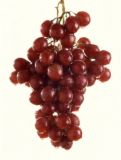 Grape
Grape Grape
GrapeGRAPE Properties: It is sweet, cooling, strengthening and nutritious fruit. Usefulness: It relieves thirst, burning sensations, fever, shortness of breath, bitter taste in the mouth and bleeding. It is useful as a laxative. FOOD VALUE Moistire 92.0% Protein 0.7% Fat 0.1% Minerals 0.2% Carbohydrates 11.6% n 100% MINERALS AND VITAMINS Calcium 20mg Phosphorus 20mg Iron 0.2mg Vitamin C 31mg Small amount of Vitamin B Complex
http://www.pediatriconcall.com/forpatients/DietandDisease/grape.asp
Adding Value to the Wine Industry Summary Enology and Viticulture Programs at Cornell help New York’s wine and grape industry by providing research-based technology and education that helps grow the industry. Over the last 30 years, enologists and viticulturists at Cornell have helped the NYS wine industry open 194 wineries, now located in eight viticultural regions across the state. The wine and grape industry contributes over $6B in gross sales to the NY economy. The Issue The Cornell Enology and Viticulture Programs provide information to the wine and grape industries which allows them to produce very high quality, internationally competitive wines. Further investment in research and education is needed to allow this industry to continue its growth. The NY and Northeastern US needs site-specific information generated at Cornell by programs in enology, viticulture and plant protection in order to be successful. Researchers provide answers to what cultivars can be grown, how to grow them, how to manage pests, soils, and water, how grapes should be managed to achieve desired flavor maturity, what wine flavor profile can be expected, and how consistent wine quality can be achieved. Research in the chemistry and biochemistry of grape flavor ripening and the translation of these grape flavors into wine flavors is being explored. Response Impacts Programs at Cornell have helped to identify key wine grape varieties for New York State and develop wines of unique and high quality from signature varieties like Chardonnay, Riesling, and, more recently, Cabernet Franc and Lemberger. Of the 53 grapes developed and released since 1906 by Cornell, six have been wine grapes. They include Cayuga White, Chardonel, Traminette, Melody, Horizon, and GR7. New projects linking plant physiology with flavor chemistry and grape genomics help growers and winemakers understand the processes of flavor maturation. On the wine processing side, enologists at Cornell study microorganisms and their physiological potential to direct flavor development during wine production. Problems and opportunities in the New York wine industry are explored in almost daily communication between members of the Cornell Enology Extension Program and grape growers and winemakers in NY. Research and industry members exchange information in close communication via personal visits and industry workshops. Wineries and vineyards offer unique opportunities for economic development in NY, from Long Island’s North Shore, to the Hudson Valley, to the Finger Lakes, to Lake Erie and the Niagara Escarpment.
http://www.cals.cornell.edu/cals/public/impact/nys-wine-industry.cfm
For further information on The Grape go to: